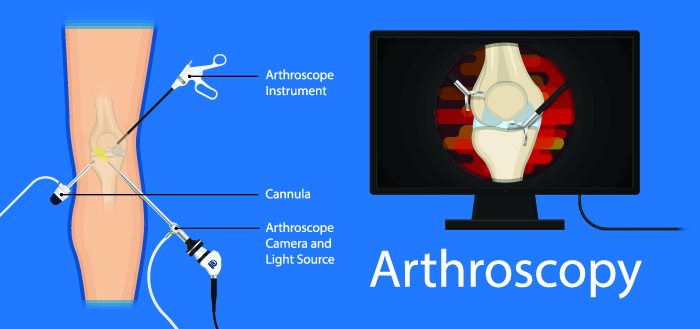Orthopedic Surgery - Knee Arthroscopy Procedure in Koramangala, Bangalore
What is Knee Arthroscopy?
Arthroscopic knee surgery is a viable treatment option for certain types of knee pain. It is a procedure that entails attaching a small camera inside the joint. Knee arthroscopy is a hi-tech surgical procedure that can be used to diagnose and treat issues of the knee joint. Specialized knee arthroscopy procedures are minimally invasive surgeries compared to open forms of surgery. Your orthopedic surgeon will make a small incision in your knee and insert an arthroscope, a small camera. On a screen, the surgeon can see what is going on inside the joint. Your ortho surgeon can use small instruments contained within the arthroscope to investigate a knee problem and correct it. It can also help repair the joint’s ligaments. The procedure carries a few risks, but most patients have a positive outcome. Your surgeon assesses your recovery time, the severity of your knee problem’s prognosis, and the depth of the procedure required. Medical professionals refer to arthroscopic knee surgery as “scoping the knee” or knee arthroscopy.

Your surgeon examines and treats problems with an inserted arthroscope after directly making skin incisions. The procedure takes less than an hour, and serious complications are rarely seen. People may favor it instead of other surgical procedures because of certain advantages of arthroscopy. Knee arthroscopy ensures less tissue damage, fewer stitches, less pain after the procedure, and a minor risk of infection because of small incisions. Overall, it has a shorter healing time.If you are preparing for knee arthroscopy, you may need to stop eating twelve hours before the procedure. Your doctor will inform you about the diet you may need to follow. Your doctor will advise you to avoid NSAIDs, OTC painkillers, and anti-inflammatory combination medicines. Knee arthroscopy surgery can involve diagnosing various issues, including chronic joint pain, stiffness, deteriorated cartilage, floating bones, cartilaginous fragments, etc. The arthroscopic procedure will diagnose and treat knee injuries such as torn anterior or posterior cruciate ligaments, torn meniscus, loose bits of torn cartilage in the joints, fractures in the knee bones, and swollen synovium.
How Do Orthopedists Perform Knee Arthroscopy?
Your orthopedist may administer a local anesthetic to desensitize only the affected knee. Your doctor may use a regional anesthetic to numb both affected knees from the waist down. Depending on the knee arthroscopy procedure, the type of anesthetic used to numb the pain will vary. Sometimes, doctors will use a general anesthetic. In such cases, patients will be asleep during the procedure. A patient can even view the procedure on a monitor if he is awake, which is an option. However, some patients may not be comfortable viewing this. The knee arthroscopy starts with a few minor cuts in the knee. Orthopedists use a pump to inject a saline solution into the affected area. The knee will expand because of this action, making it easier for doctors to see their work. Your orthopedist inserts an arthroscope as the knee expands. The attached camera enables the surgeons to inspect the area and identify any problems. They may confirm previous diagnoses and take photographs. If your doctor can fix the problem with arthroscopy, he will insert small tools through the arthroscope and use them to correct the issue. After fixing the problem, your surgeons will remove the tools, use the pump to drain the saline or fluid from the knee, and stitch up the incisions. Usually, the procedure takes less than an hour.
Conclusion:
One of the most important surgical procedures performed by an orthopedist is arthroscopic knee surgery. Doctors use minor incisions and ensure minimal soft tissue damage when performing arthroscopic surgery. Many forms of knee surgery can be resolved through knee arthroscopy. It can help patients remain fit. Also, patients can perform activities better than before.
Arthroscopic knee surgery takes at least six weeks to heal. If your doctor repairs damaged tissue, recovery would take longer. Restrict your activities until your knee movement is back to normal. However, you can attend a physical rehabilitation program for a speedy recovery.
Adding ice packs to the dressing and surrounding area to relieve swelling and discomfort, keeping the leg elevated for several days after surgery, resting well, adjusting the dressing, and following the doctor’s advice on applying weight to the knee are helpful recovery tips.
An ACL injury (tear or sprain) causes severe pain, knee instability, or it occurs as a mix of the two. There may be a lot of swelling because of hematoma collection in the joint.
Orthos surgeons follow procedures such as partial meniscectomy or removal of the torn meniscus, meniscal repair, removal of loose fragments, smoothing of joint surfaces (chondroplasty), removal of the inflamed joint lining, and cruciate reconstruction.
Symptoms
Our Top Specialities
NOTICE BOARD
CONTACT US
CONTACT US
 Book Appointment
Book Appointment


.svg)
.svg)
.svg)
.svg)








